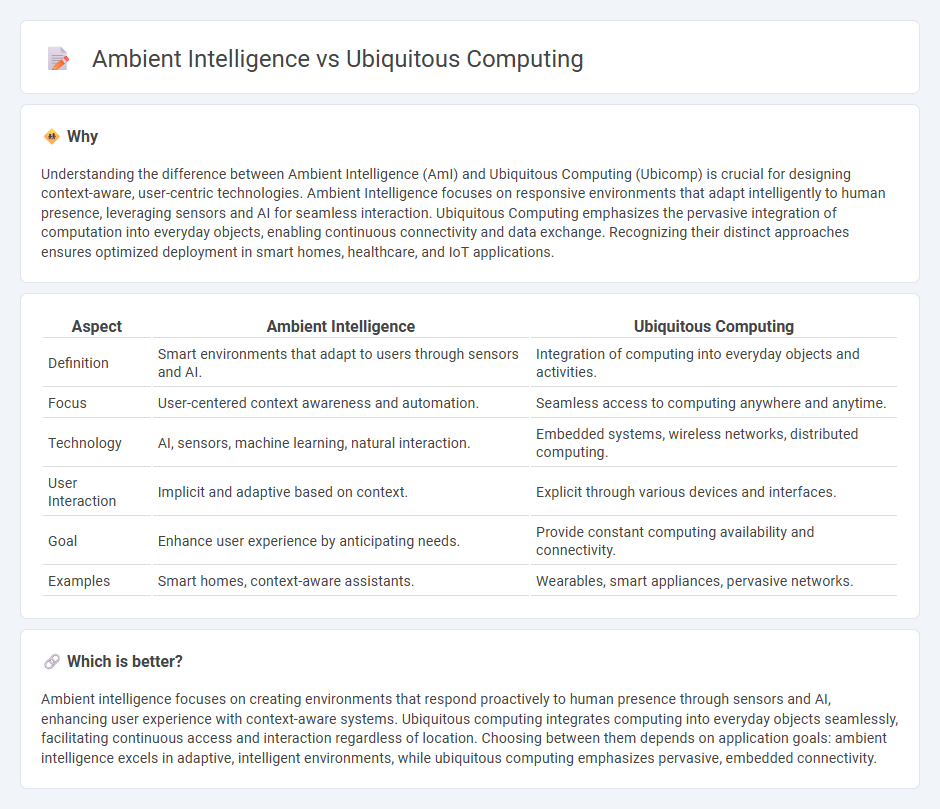
Ambient intelligence integrates AI seamlessly into everyday environments to create context-aware, adaptive systems that enhance user experience through automation and personalization. Ubiquitous computing focuses on embedding computational capabilities into all objects and locations, enabling constant connectivity and interaction without explicit user engagement. Explore the distinctions between these innovative technological paradigms to understand their impact on future smart environments.
Why it is important
Understanding the difference between Ambient Intelligence (AmI) and Ubiquitous Computing (Ubicomp) is crucial for designing context-aware, user-centric technologies. Ambient Intelligence focuses on responsive environments that adapt intelligently to human presence, leveraging sensors and AI for seamless interaction. Ubiquitous Computing emphasizes the pervasive integration of computation into everyday objects, enabling continuous connectivity and data exchange. Recognizing their distinct approaches ensures optimized deployment in smart homes, healthcare, and IoT applications.
Comparison Table
| Aspect | Ambient Intelligence | Ubiquitous Computing |
|---|---|---|
| Definition | Smart environments that adapt to users through sensors and AI. | Integration of computing into everyday objects and activities. |
| Focus | User-centered context awareness and automation. | Seamless access to computing anywhere and anytime. |
| Technology | AI, sensors, machine learning, natural interaction. | Embedded systems, wireless networks, distributed computing. |
| User Interaction | Implicit and adaptive based on context. | Explicit through various devices and interfaces. |
| Goal | Enhance user experience by anticipating needs. | Provide constant computing availability and connectivity. |
| Examples | Smart homes, context-aware assistants. | Wearables, smart appliances, pervasive networks. |
Which is better?
Ambient intelligence focuses on creating environments that respond proactively to human presence through sensors and AI, enhancing user experience with context-aware systems. Ubiquitous computing integrates computing into everyday objects seamlessly, facilitating continuous access and interaction regardless of location. Choosing between them depends on application goals: ambient intelligence excels in adaptive, intelligent environments, while ubiquitous computing emphasizes pervasive, embedded connectivity.
Connection
Ambient intelligence integrates sensors, artificial intelligence, and IoT devices to create smart environments that adapt to user needs seamlessly. Ubiquitous computing provides the infrastructure by embedding computational capabilities into everyday objects and environments, enabling constant connectivity and interaction. Together, they enable context-aware systems that enhance user experience through real-time data processing and adaptive responses.
Key Terms
Context-awareness
Ubiquitous computing integrates computing devices seamlessly into everyday environments, emphasizing continuous context-awareness through sensors and adaptive systems. Ambient intelligence extends this by creating environments that proactively respond to user needs with enhanced context-awareness using AI and machine learning techniques. Explore how these technologies redefine human-computer interaction through intelligent context-aware solutions.
Pervasive devices
Ubiquitous computing integrates pervasive devices seamlessly into everyday environments, enabling constant connectivity and data exchange without user intervention. Ambient intelligence leverages these pervasive devices with advanced sensors, artificial intelligence, and context-awareness to create adaptive, personalized environments that anticipate user needs. Discover how pervasive devices revolutionize smart environments by exploring the intersection of ubiquitous computing and ambient intelligence.
Adaptive environments
Ubiquitous computing integrates technology seamlessly into everyday environments to provide continuous access to information, while ambient intelligence emphasizes context-aware systems that adapt proactively to user needs within smart environments. Adaptive environments combine sensors, actuators, and machine learning algorithms to create spaces that respond dynamically to changes in occupants' behavior and preferences. Explore how these technologies transform living and working spaces by enhancing comfort, efficiency, and personalization.
Source and External Links
What is Ubiquitous Computing? - Ubiquitous computing, or pervasive computing, refers to seamlessly integrating computing capabilities into everyday objects--such as lights, cameras, wearables, and sensors--enabling them to communicate, collect data, and proactively respond to user needs without direct interaction.
Ubiquitous computing - Ubiquitous computing is a paradigm in computer science where computing is made to appear anytime, everywhere, and on any device, blending into the background to become nearly invisible to users as they go about their daily lives.
Comprehensive Guide to Ubiquitous Computing: Impact & ... - Pervasive, embedded computing enables devices to gather environmental data through sensors, process it with AI, and act via actuators, often operating so seamlessly that their presence is barely noticed, while relying on advanced connectivity and data processing technologies.
 dowidth.com
dowidth.com